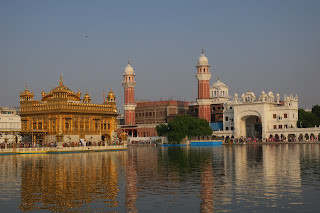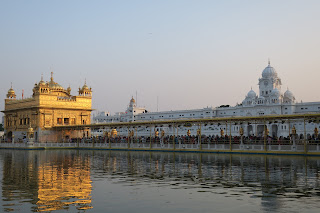The Golden Temple, also known as Harmandir Sahib, meaning "abode of God" or
Darbār Sahib, meaning "exalted court", is a Gurdwara located in the city of
Amritsar, Punjab, India. It is the holiest Gurdwara and the most important
pilgrimage site of Sikhism.
The temple is built around a man-made pool (sarovar) that was completed
by Guru Ram Das in 1577. The temple was repeatedly rebuilt by the Sikhs after
it became a target of persecution and was destroyed several times by the
Muslim armies from Afghanistan and the Mughal Empire. The army led by Ahmad
Shah Abdali, for example, demolished it in 1757 and again in 1762, then filled
the pool with garbage and blood of cows.
Maharaja Ranjit Singh after founding the Sikh Empire, rebuilt it in marble and
copper in 1809, overlaid the sanctum with gold foil in 1830. This has led to
the name the Golden Temple. The temple is spiritually the most significant
shrine in Sikhism.
The Harmandir Sahib is an open house of worship for all men and women, from
all walks of life and faith. It has a square plan with four entrances, has a
circumambulation path around the pool. The temple is a collection of buildings
around the sanctum and the pool. One of these is Akal Takht, the chief center
of religious authority of Sikhism. Additional buildings include a clock tower,
the offices of Gurdwara Committee, a Museum and a langar – a free Sikh
community run kitchen that serves a simple vegetarian meal to all visitors
without discrimination. Over 100,000 people visit the holy shrine daily for
worship.
|
Approaching the Golden Temple.
The Main Entrance and Clock Tower (No. 1) is in the center.
|
|
Golden Temple map
Image legend:
- Main Entrance and Clock Tower.
- Central Sikh Museum.
- Tree Baba Buddha Ji Ber.
- Information Office.
- Ninth Guru's Shrine (Tharra Sahib).
- Sri Akal Takhat Sahib.
- Flagstaffs (Nishaan Sahib).
- Darshani Deorhi.
- Tree Gurdwara Laachi Ber.
- Causeway.
- Sanctum Sanctorum.
- Holy Pool of Immortal Nectar (Sarovar).
- Circumambulatory (Parikrama).
- Baba Deep Singh Shrine.
- Sixty-eight Sacred Places (Ath-sath Tirath).
- Tree Gurdwara Dukh Bhanjani Ber.
- Watch Towers.
- Guru ka Langar.
- Manji Sahib Dewan Hall.
- Guru Arjan Dev Niwas.
- Guru Ramdas Sarai.
- Teja Singh Samundari Hall.
- Guru Nanak Niwas.
- Guru Hargobind Niwas.
- Gurdwara Baba Atal Sahib
|
|
Entering the Golden Temple.
|
|
Leaving shoes and socks behind.
At the entrance we have to leave our shoes and socks.
|
|
Walking towards the Flagstaffs (Nishaan Sahib) (No. 7).
|
|
Ninth Guru's Shrine (Tharra Sahib) (No. 5).
Guru Tegh Bahadur (1 April 1621 – 11 November 1675) was the ninth of ten
gurus who founded the Sikh religion and was the leader of Sikhs from
1665 until his beheading in 1675.
-
Considered a principled and fearless warrior, he was a learned
spiritual scholar and a poet whose 115 hymns are included in the Guru
Granth Sahib, which is the main text of Sikhism.
-
See more at
Guru Tegh Bahadur - Wikipedia.
|
|
Going down towards the pool.
Guru Arjan planned a gurdwara at a level lower than the city to
emphasize humility and the need to efface one's ego before entering the
premises to meet the Guru.
|
|
Rinsing our feet in water to remove any impurities.
Before entering the most sacred part of the temple, we have to rinse our
feet in water to remove any impurities.
|
|
Sri Akal Takhat Sahib (No. 6).
The Akal Takht (lit. 'Throne of the Timeless One') is one of five seats
of power (takhts) of the Sikhs.
-
The Akal Takht was built by Guru Hargobind as a place of justice and
consideration of temporal issues; the highest seat of earthly
authority of the Khalsa (the collective body of the Sikhs) and the
place of the Jathedar, the highest spokesman of the Sikhs.
-
See more at
Akal Takht - Wikipedia.
|
|
Food is offered to visitors.
|
|
Darshani Deorhi (No. 8).
The archway leading to the Golden Temple’s sanctum sanctorum.
|
|
Tree Gurdwara Laachi Ber (No. 9).
Laachi Ber is believed to the tree under which Guru Arjan rested while
the temple was being built.
|
|
Sanctum sanctorum, Holy Pool and causeway.
The Sanctum sanctorum is in the center (No. 11), the Holy Pool
(Sarovar) is below (No. 12), and the causeway is on the left (No.
10).
|
|
Circumambulatory (Parikrama) (No. 13).
|
|
Sanctum sanctorum (No. 11) and Watchtowers (No. 17).
The Ramgarhia Bunga – the two high towers visible from the
circumambulation (parikrama) walkway around the tank, is named
after a Sikh subgroup.
-
The red sandstone minaret-style Bunga towers were built in the 18th
century, a period of Afghan attacks and temple demolitions.
-
It was constructed as the temple watchtowers for sentinels to watch
for any military raid approaching the temple and the surrounding area,
help rapidly gather a defense to protect the Golden Temple complex.
-
See more at
Ramgarhia Bunga - Wikipedia.
|
|
Tree Gurdwara Laachi Ber (No. 9) and Sanctum sanctorum (No. 11).
|
|
Holy Pool of Immortal Nectar (Sarovar) (No. 12).
The first structure of the Harmandir Sahib constructed under the purview
of Guru Arjan combined the concepts of dharamsaals and the holy
water tanks (sarovar).
-
Rather than copying the traditional method of Hindu temple
construction by building the shrine on a high plinth, Guru Arjan
rather decided to build the shrine lower than the surroundings so that
devotees would have to walk downwards to reach it.
|
|
Southwest entrance.
The Golden Temple is an open house of worship for all people, from all
walks of life and faiths. It has a square plan with four entrances, and
a circumambulation path around the pool.
-
The four entrances to the pool symbolises the Sikh belief in equality
and the Sikh view that all people are welcome into their holy place.
|
|
Main entrance (No. 1) and Sanctum sanctorum (No. 11).
The Main Entrance is on the left, the Sanctum sanctorum is on the right,
and the Holy pool is below.
|
|
Sri Akal Takhat Sahib (No. 6), Gurdwara Laach tree (No. 9) and
Flagstaffs (No. 7).
|
|
Sanctum sanctorum (No. 11) from southwest.
|
|
Sanctum sanctorum (No. 11) from south.
Ber Baba Buddha tree (center in the distance) (No. 3) is believed in the
Sikh tradition to be the tree where Baba Buddha sat to supervise the
construction of the pool and first temple.
|
|
Bathing in the Holy pool (No. 12).
Bathing in the pool is believed by many Sikhs to have restorative
powers, purifying one's karma.
-
Some carry bottles of the pool water home particularly for sick
friends and relatives.
-
The pool is maintained by volunteers who perform kar seva (community
service) by draining and desilting it periodically.
|
|
Baba Deep Singh Shrine (No. 14).
Baba Deep Singh (26 January 1682 – 13 November 1757) is revered among
Sikhs as one of the most hallowed martyrs in Sikhism.
-
Baba Deep Singh had vowed to avenge the desecration of the Golden
Temple by the Afghan army. In 1757, he led an army to defend the
Golden Temple. The Sikhs and the Afghans clashed in the Battle of
Amritsar on 13 November 1757, and in the ensuing conflict Baba Deep
Singh was decapitated.
-
The spot where Baba Deep Singh's head fell is marked in the Golden
Temple complex, and Sikhs from around the world pay their respects
there.
-
See more at
Baba Deep Singh - Wikipedia.
|
|
Sixty-eight Sacred Places (No. 15) and Tree Gurdwara Dukh Bhanjani
Ber (No. 16).
The Ath Sath Tirath is below, next to the pool, at the end of the red
carpet. The tree is visible on the right. This photo was taken from
inside the southeast entrance.
-
Ath Sath Tirath, which means "shrine of 68 pilgrimages", is a raised
canopy on the parkarma (circumambulation marble path around the pool).
The name reflects the belief that visiting this temple is equivalent
to 68 Hindu pilgrimage sites in the Indian subcontinent, or that a
Tirath to the Golden Temple has the efficacy of all 68 Tiraths
combined.
-
It is believed in the Sikh tradition that Dukh Bhanjani Ber tree was
the location where a Sikh was cured of his leprosy after taking a dip
in the pool, giving the tree the epithet of "suffering remover".
|
|
Passing our feet through water again.
To leave the most sacred area we have to rinse our feet in water to
cleanse the impurities.
|
|
Entering the dining room and kitchen (Langar) (No. 18).
A langar is the community kitchen of a place of assembly and worship for
Sikhs, which serves meals to all free of charge, regardless of religion,
caste, gender, economic status, or ethnicity.
-
People sit on the floor and eat together, and the kitchen is
maintained and serviced by Sikh community volunteers who are doing
selfless services (seva).
-
The meals served at a langar are always lacto-vegetarian (Satvik).
-
See more at
Langar (Sikhism) - Wikipedia.
|
|
Volunteers prepare the ingredients for the meal.
|
|
Rolling Chapati.
Chapati is an unleavened flatbread originating from the Indian
subcontinent and is a staple in India, Nepal, Bangladesh, Pakistan, Sri
Lanka, East Africa, the Arabian Peninsula and the Caribbean.
-
Chapatis are made of whole-wheat flour known as atta, mixed
into dough with water, oil (optional) and salt (optional).
-
Small portions of the dough are pinched off and formed into round
balls that are pressed between the two palms to form discs which are
then dipped into flour and rolled out on a circular rolling board
(chakla), using a rolling pin known as a velan or belan,
into a flat disc.
-
See more at
Chapati - Wikipedia.
|
|
Cooking Chapati.
The rolled-out dough is then thrown on the preheated dry flat skillet
(tava) and cooked on both sides.
|
|
Making Dal.
Dal are dried, split pulses (e.g., lentils, peas, and beans) that do not
require soaking before cooking. India is the largest producer of pulses
in the world.
-
The term is also used for various soups prepared from these pulses.
-
These pulses are among the most important staple foods in South Asian
countries, and form an important part of the cuisines of the Indian
subcontinent.
-
See more at
Dal - Wikipedia.
|
|
Community meal.
The place of assembly and worship for Sikhs is the location for the
historic Sikh practice of "Langar" or the community meal.
-
All places of assembly and worship for Sikhs are open to anyone of any
faith for a free meal, always vegetarian.
-
People eat together, and the kitchen is maintained and serviced by
Sikh community volunteers.
|
|
Going through the southeast entrance again.
After visiting the kitchens and restaurant, we crossed the southeast
entrance again.
|
|
Golden Temple seen from north.
|
See also
Source
Location


















































































